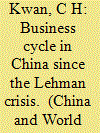| Srl | Item |
| 1 |
ID:
122943


|
|
|
|
|
| Publication |
2013.
|
| Summary/Abstract |
The major objectives of China's macroeconomic policy are to stabilize economic growth and inflation, which, in turn, are important factors determining key prices, such as the policy interest rate, the renminbi exchange rate and stock prices. In a framework that distinguishes different phases of the business cycle based on whether the current period's economic growth rate and inflation rate are above or below their "normal" values, this paper analyzes the interaction among macroeconomic policy, economic growth and inflation in China since the Lehman crisis, and the implications for these key prices. The path of China's economy indicates that stimulus measures taken by the government during the recession phase and tightening measures implemented during the overheating phase have helped minimize the fluctuation over the business cycle. Our analysis shows that Chinese authorities tend to rely more on adjusting the exchange rate than the interest rate to stabilize the economy. Comparing with conditions at the time of the post-Lehman recession, the current slow pace of economic growth in China may reflect not only weakening demand, but also a lower potential growth rate associated with the arrival of the Lewis turning point.
|
|
|
|
|
|
|
|
|
|
|
|
|
|
|
|
| 2 |
ID:
110249


|
|
|
|
|
| Publication |
2012.
|
| Summary/Abstract |
This paper introduces a regime-switching forward-looking Taylor rule to describe the monetary policy behavior and considers its estimation using a two-step MLE procedure due to Kim and Nelson (2006), Kim (2009) and Zheng and Wang (2010). By doing an empirical analysis on quarterly data for China over the period 1992-2010, our results show that the actual reactions of China's monetary policy can be well characterized by a two-regime forward-looking Taylor rule. Furthermore, it is also suggested that the interest rate policy in response to inflation and output gap is asymmetric, behaving a significant characteristic of regime-switching nonlinearity. Specifically, in the first regime the People's Bank of China targets inflation, but not focuses on the output gap; while in the second regime the central bank targets the output gap and the policy rule is not a stable framework.
|
|
|
|
|
|
|
|
|
|
|
|
|
|
|
|
| 3 |
ID:
173201


|
|
|
|
|
| Summary/Abstract |
We verify the potential impact of credit-enhanced monetary policy rule on inflation, GDP and credit dynamics in Turkey (2002Q1—2018Q3), where the Turkish Cental Bank takes into account financial stability in its inflation-targeting strategy. We estimate interest rates from two monetary policy rules (classic and augmented with the exogenous credit-to-GDP gap) with time-varying parameters (TVP) and assess their performance in a TVP-VAR model. The results show that after the global crisis both observed interest rates and those estimated from the Taylor-rule impact inflation and the GDP in a similar way. The central bank’s monetary policy after 2010 was in line with the Taylor rule and took into account cyclical systemic risk with increased strength in the monetary transmission mechanism. Yet, before the crisis, both types of Taylor rules indicate that the bank’s monetary policy should have been more restrictive.
|
|
|
|
|
|
|
|
|
|
|
|
|
|
|
|